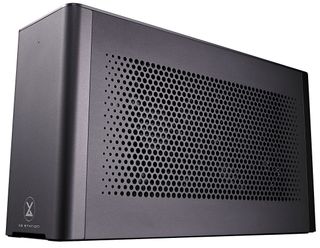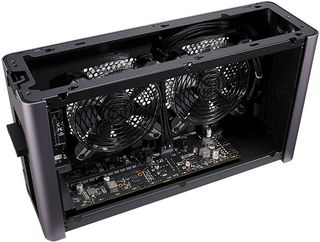Asus unveils an external GPU enclosure for graphics pros, but works for games
Turn that Zenbook into a graphics powerhouse.

External graphics docks are not a new thing by any means. In fact, Asus introduced its first model, the original XG Station, way back in 2007. Now more than a decade later, Asus is introducing the XG Station Pro, a somewhat conservative looking eGPU dock with Thunderbolt 3 connectivity.
Compared to some other external graphics boxes such as PowerColor's Devil Box, Dell's Alienware Graphics Amplifier, and Gigabyte's Aorus Gaming Box, the XG Station Pro has a tone down demeanor. That's to reflect the target audience—graphics professionals who deal with "serious 3D modeling and CAD," as opposed to gamers.
"The new ASUS XG Station Pro brings professionals the refinement you’d expect from our decade of experience with external GPUs. Its sleek exterior hides high-end graphics cards inside a compact chassis that fits seamlessly into your space, while intelligent cooling keeps you running at top speed with minimal acoustic accompaniment. The included Thunderbolt 3 cable plugs into a wide range of ultrabooks and laptops, making the XG Station Pro a versatile solution for ZenBooks and MacBooks alike," Asus says.
That doesn't mean you couldn't use the XG Station Pro to boost the gaming performance of an ultrabook, and the design may appeal to gamers looking for something a little more professional looking. Asus alludes to this, calling the XG Station Pro its "business-class brother tailored for work before play."
Either way, the XG Station Pro offers compatibility with the latest graphics cards from AMD and Nvidia. There's enough room inside to cram a full-size card that's up to 2.5 slots wide, including the ROG Strix version of the GeForce GTX 1080 Ti and Radeon RX Vega 64. Asus says it's compatible with all cards from the GeForce GTX 900 and Radeon R9 series on up, in Windows 10.

The box has a relatively small footprint, measuring 4.3 inches by 14.8 inches. It's slim profile comes with a compromise—Asus moved the power supply out of the case and into a separate adapter.
"External bricks usually max out around 240W, which isn’t enough for top-of-the-line cards, but the XG Station Pro has no problem keeping up thanks to a beefy 330W unit borrowed from ROG’s liquid-cooled GX800 gaming laptop," Asus explains.
The biggest gaming news, reviews and hardware deals
Keep up to date with the most important stories and the best deals, as picked by the PC Gamer team.
For comparison, the latest version of PowerColor's Devil Box uses an internal 550W PSU with 80 Plus Gold certification, and Gigabyte's Gaming Box has a 450W PSU on board (also 80 Plus Gold certified).
Asus splits the power between the PCIe slot and dual 8-pin connectors, claiming there's enough juice to handle its factory overclocked ROG Strix cards. Going forward, Asus says it plans to make all future graphics cards compatible with the XG Station Pro.
In addition to Thunderbolt 3 connectivity, there's an extra USB 3.1 Gen 2 Type-C port that can supply up to 15W of power to compatible devices.
The XG Station Pro will be available later this month for $329. That's for the box alone (with power adapter and Thunderbolt 3 cable); adding a graphics card costs extra.
Paul has been playing PC games and raking his knuckles on computer hardware since the Commodore 64. He does not have any tattoos, but thinks it would be cool to get one that reads LOAD"*",8,1. In his off time, he rides motorcycles and wrestles alligators (only one of those is true).
Most Popular






